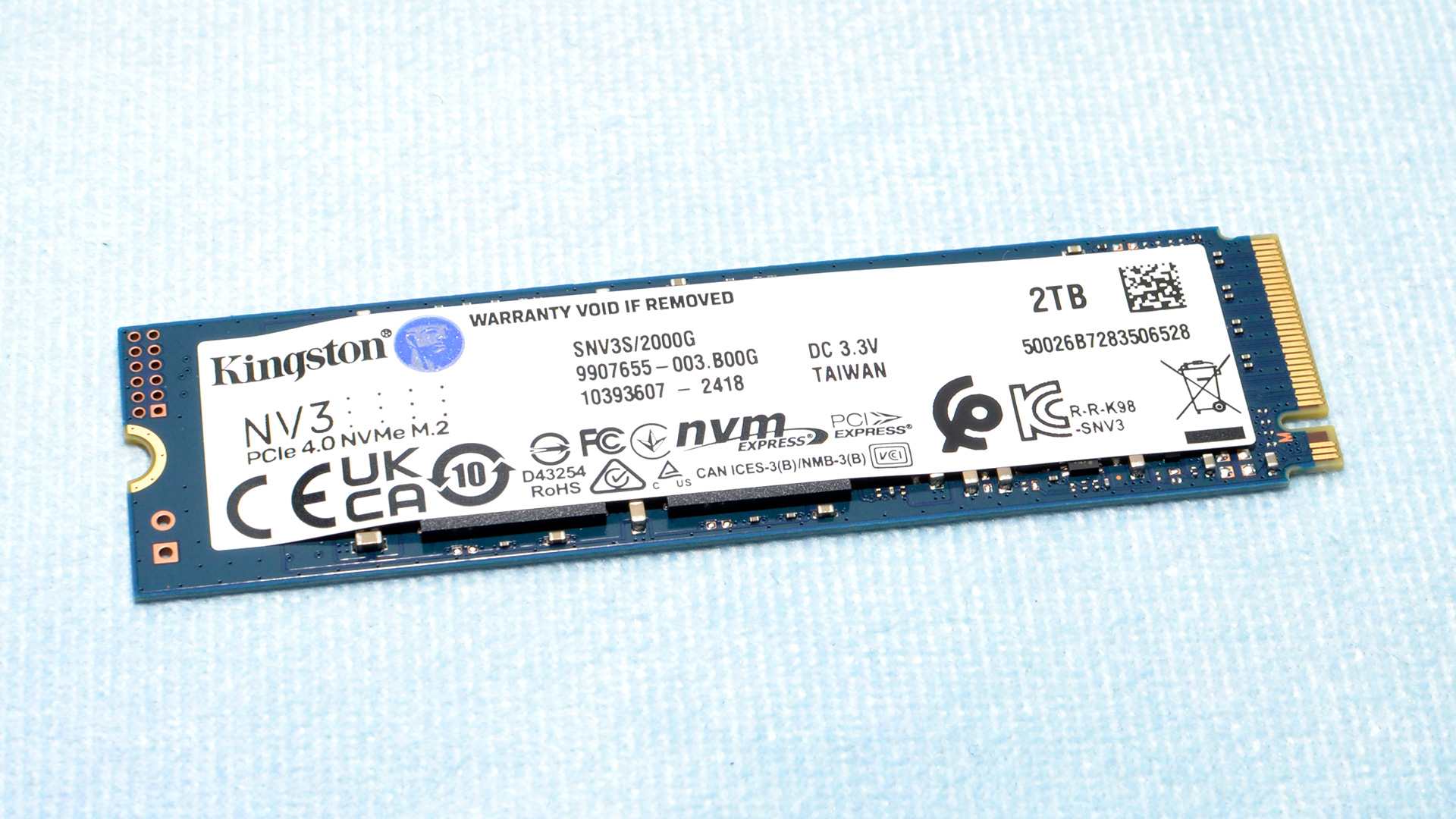Why you can trust Tom's Hardware
Comparison Products
The Kingston NV2 is a natural drive choice for comparison, showing how far budget SSD hardware has come. Other budget drives in the NV3’s range include the Corsair MP600 Elite, the Silicon Power US75, and the QLC-based HP FX700. The Crucial T500 is also technically a budget drive, although more typically it's priced along with the best PCIe 4.0 SSDs: the Samsung 990 Pro, the WD Black SN850X, and the SK hynix Platinum P41. SMI controllers are harder to find in this space, but we do have the Adata Legend 960 Max. Lastly, to round it out with a PCIe 5.0 SSD, we have the Sabrent Rocket 5 on deck to illustrate what maximum SSD performance (and a much higher price) will get you.
Trace Testing — 3DMark Storage Benchmark
Built for gamers, 3DMark’s Storage Benchmark focuses on real-world gaming performance. Each round in this benchmark stresses storage based on gaming activities including loading games, saving progress, installing game files, and recording gameplay video streams. Future gaming benchmarks will be DirectStorage-inclusive and we also include notes about which drives may be future-proofed.



Right off the bat we can see that the NV3 is a decent upgrade to the NV2. This is like-for-like as our original 2TB NV2 also uses an SMI controller and QLC flash. The flash isn’t a huge upgrade on its own, so this really demonstrates what a good controller can do. The NV3 still falls behind the rest of the drives in 3DMark, but it gets close enough that it’s not a dire situation. The NV3 would be perfectly serviceable as a gaming drive, as it’s almost hanging with the (formerly) high-end Legend 960 Max.
Trace Testing — PCMark 10 Storage Benchmark
PCMark 10 is a trace-based benchmark that uses a wide-ranging set of real-world traces from popular applications and everyday tasks to measure the performance of storage devices. The results are particularly useful when analyzing drives for their use as primary/boot storage devices and in work environments.


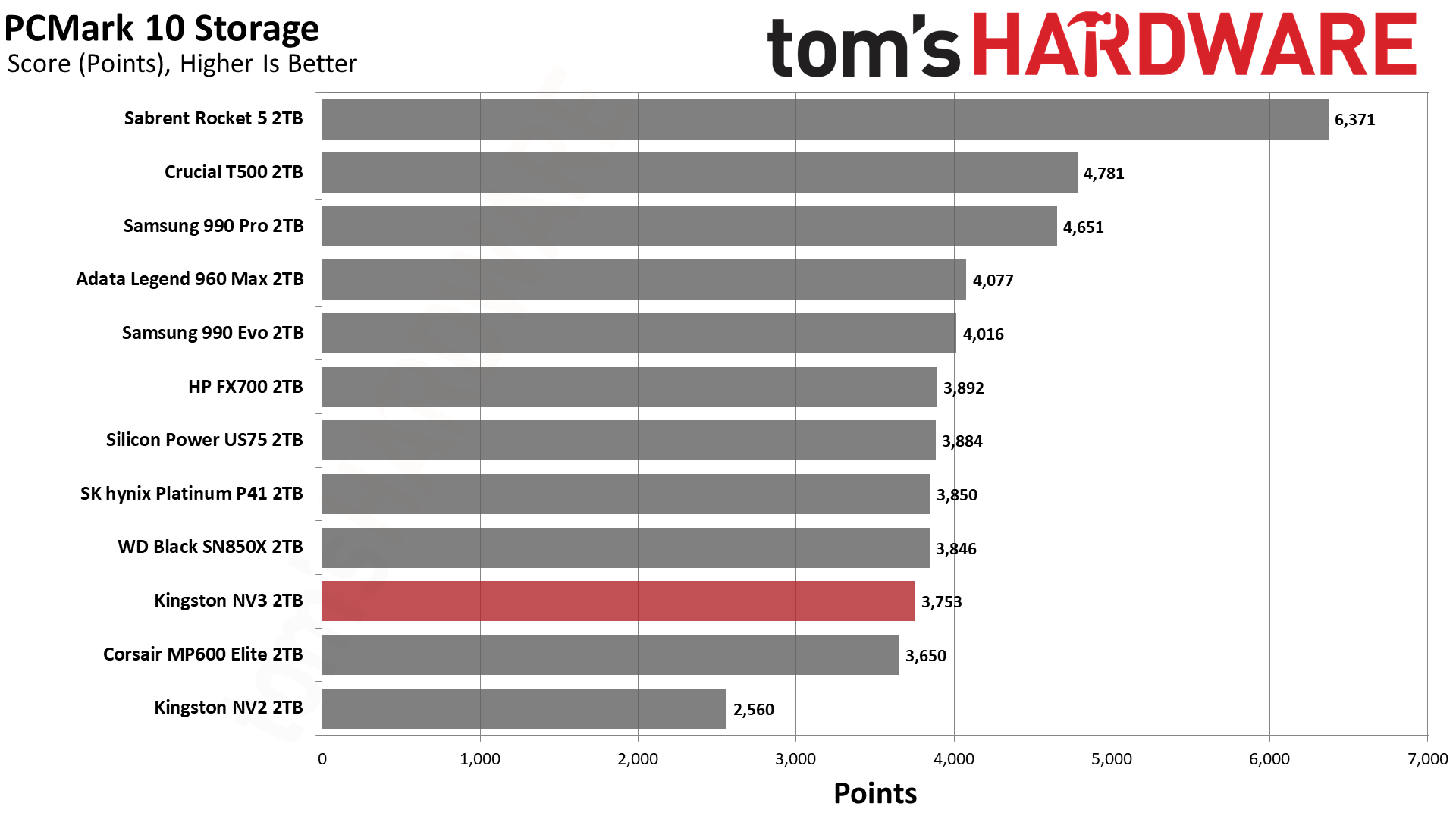
The NV3 is a little bit happier in PCMark 10, beating the MP600 Elite and getting close to the SN850X, US75, Platinum P41, and FX700. The MP600 Elite uses an equivalent controller — the Phison E27T, which can be a substitute for the NV3’s SM2268XT2 — and BiCS6 TLC flash. What this demonstrates is that BiCS6 QLC can match the BiCS6 TLC flash in this test, although we would expect the pSLC mode to perform similarly anyway. It’s possible that the SMI controller is a bit faster here, too.
Console Testing — PlayStation 5 Transfers
The PlayStation 5 is capable of taking one additional PCIe 4.0 or faster SSD for extra game storage. While any 4.0 drive will technically work, Sony recommends drives that can deliver at least 5,500 MB/s of sequential read bandwidth for optimal performance. In our testing, PCIe 5.0 SSDs don’t bring much to the table and generally shouldn’t be used in the PS5, especially as they may require additional cooling. Check our Best PS5 SSDs article for more information. Our testing utilizes the PS5’s internal storage test and manual read/write tests with over 192GB of data both from and to the internal storage. Throttling is prevented where possible to see how each drive operates under ideal conditions. While game load times should not deviate much from drive to drive, our results can indicate which drives may be more responsive in long-term use.

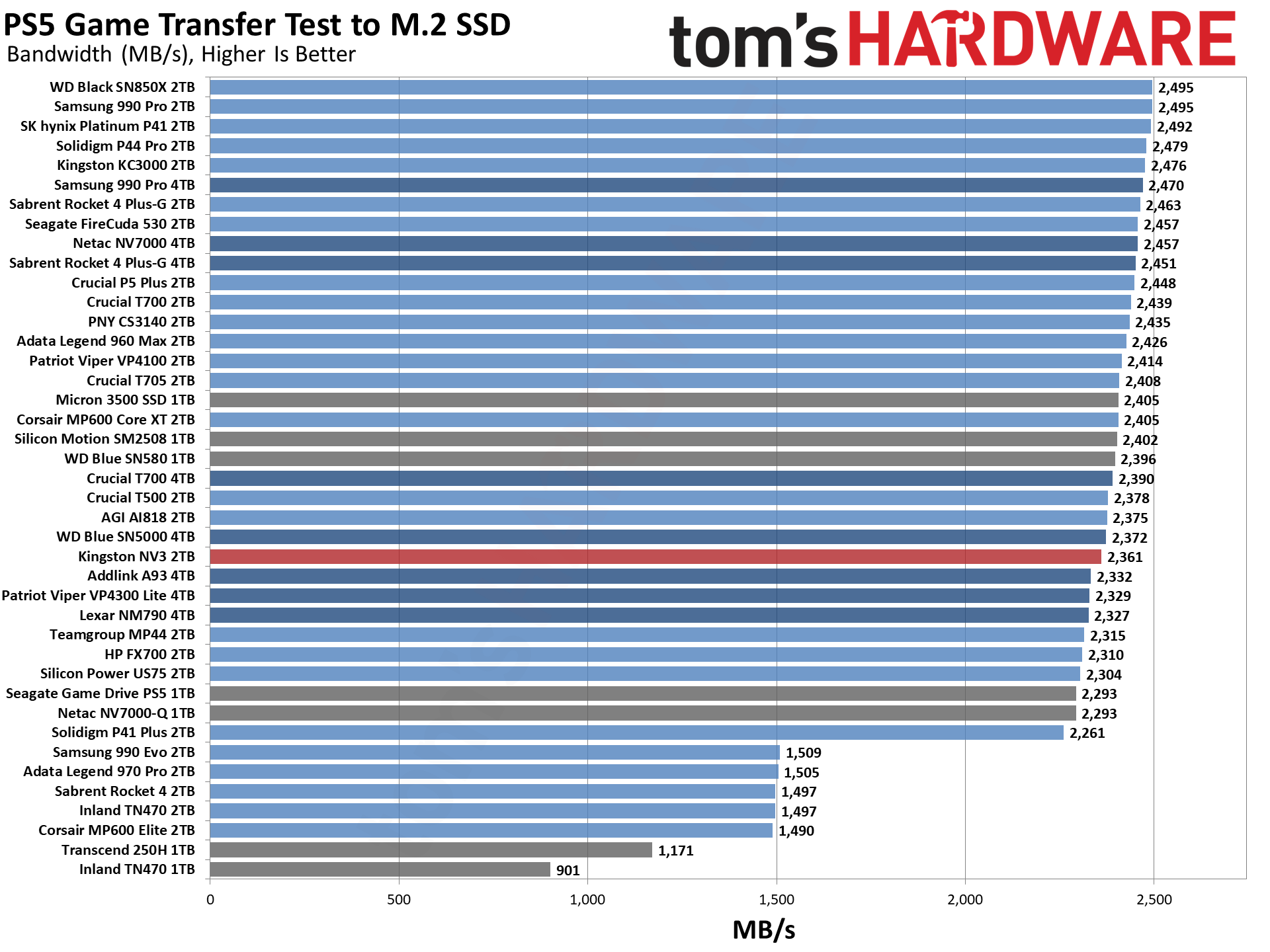

There are no anomalies to report here. The NV3 performs perfectly fine in our PS5 testing. We’d go so far as to say it’s not a bad choice for a PS5 drive, if you can find it at the right price. Based on our power and efficiency results — see below — the NV3 would be a good fit as-is without an additional heatsink.
Get Tom's Hardware's best news and in-depth reviews, straight to your inbox.
Transfer Rates — DiskBench
We use the DiskBench storage benchmarking tool to test file transfer performance with a custom, 50GB dataset. We write 31,227 files of various types, such as pictures, PDFs, and videos to the test drive, then make a copy of that data to a new folder, and follow up with a reading test of a newly-written 6.5GB zip file. This is a real world type workload that fits into the cache of most drives.
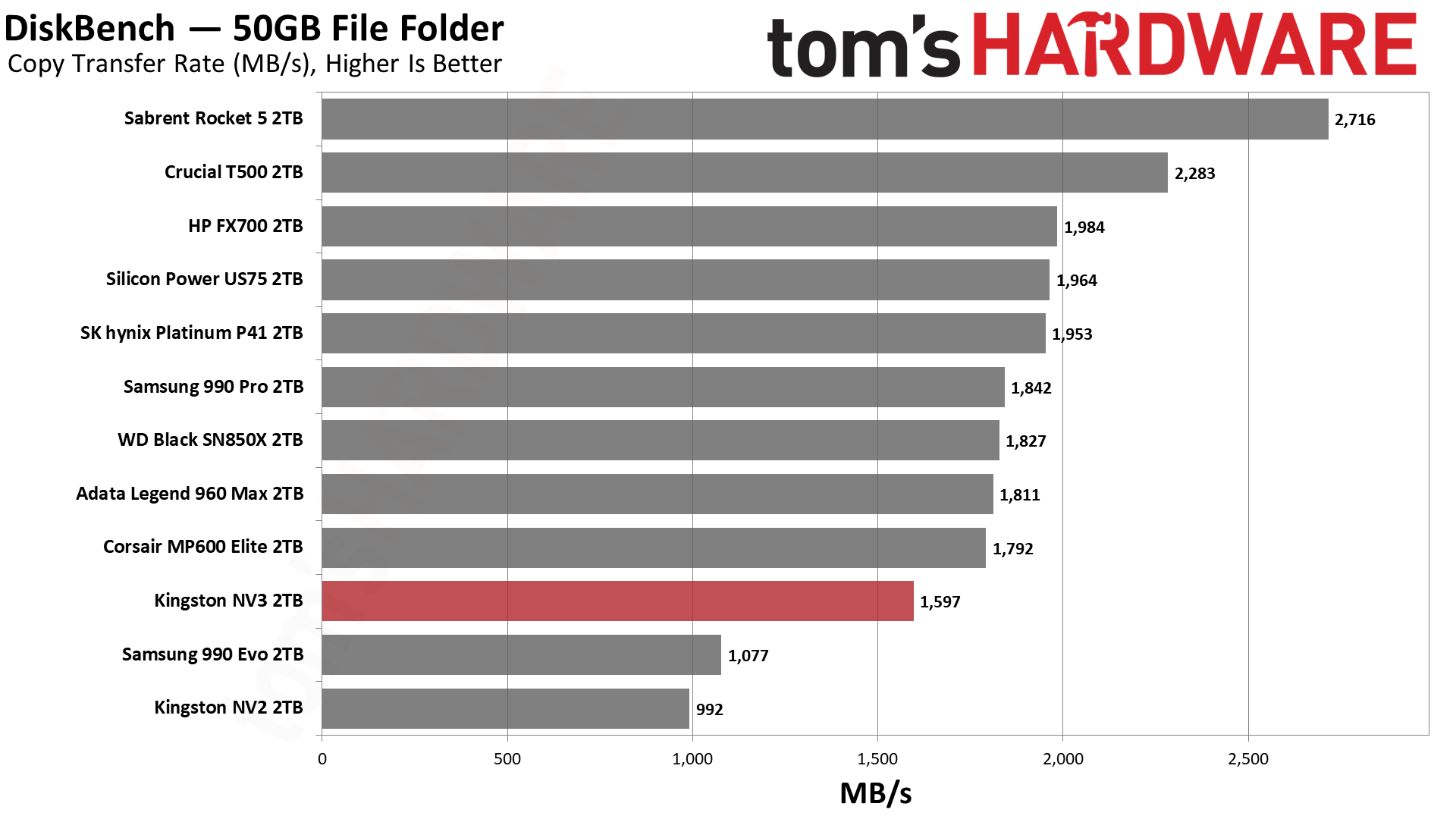


The NV3 shows a little weakness in DiskBench, although it clears the NV2 and 990 EVO easily. The latter is admittedly an odd duck for a variety of reasons — see our review for more information. The NV3 can’t quite keep up with other drives of its class, like the MP600 Elite, and this is likely due to the 6,000 MB/s cap. As mentioned earlier, we suspect the bus rate is being effectively throttled, resulting in the drop we see here.
Does this mean performance is being left on the table? Potentially, yes. As stated above, this decision gives Kingston some flexibility and can indirectly improve reliability. An argument for this decision could be that maximum sequential performance isn’t really a huge deal — the drive is already pretty fast and that workload type is less common for a budget audience — and that random performance remains strong enough. If you’re going for the fastest transfers, though, the NV3 falls off the pace.
Synthetic Testing — ATTO / CrystalDiskMark
ATTO and CrystalDiskMark (CDM) are free and easy-to-use storage benchmarking tools that SSD vendors commonly use to assign performance specifications to their products. Both of these tools give us insight into how each device handles different file sizes and at different queue depths for both sequential and random workloads.



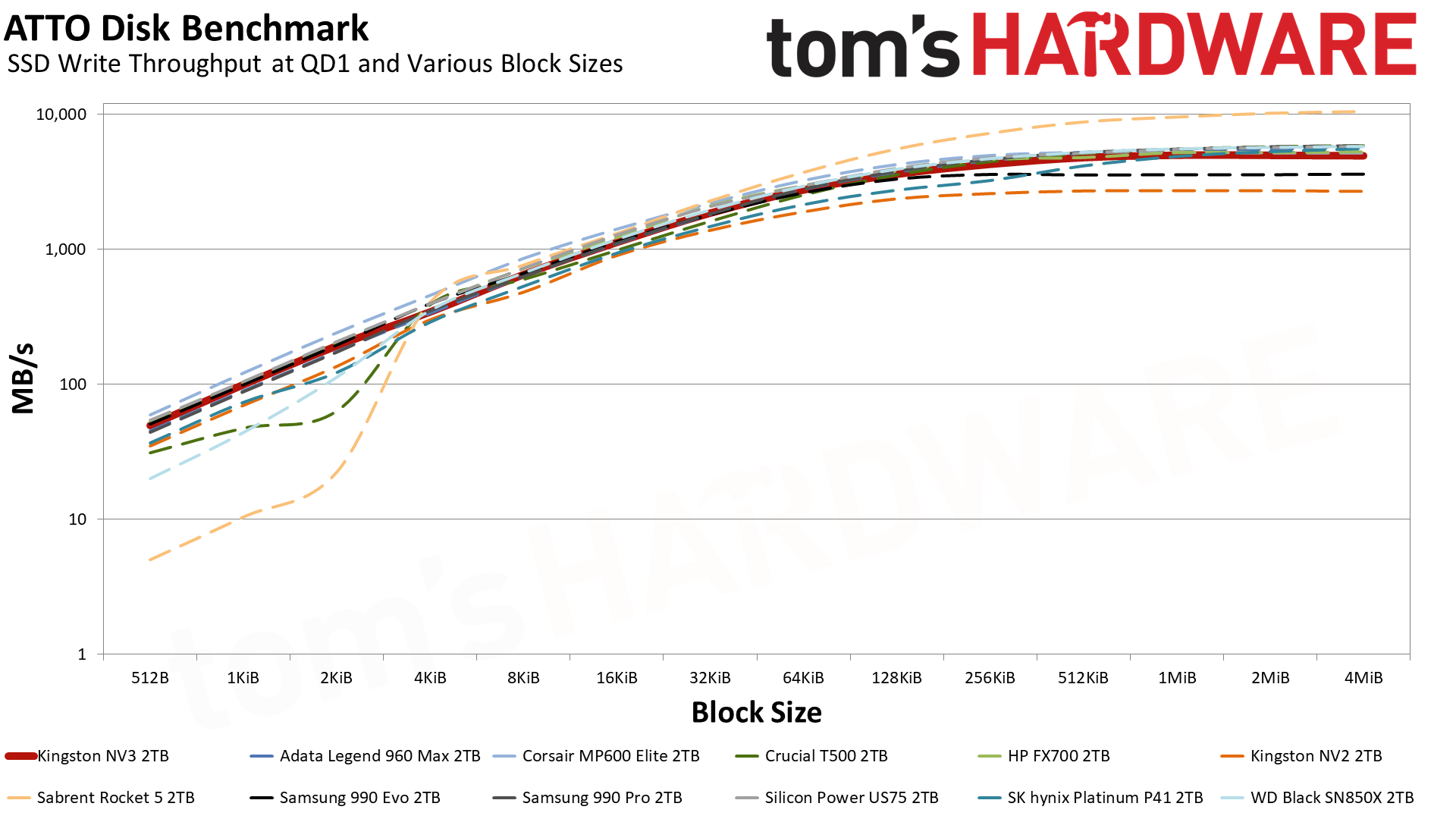



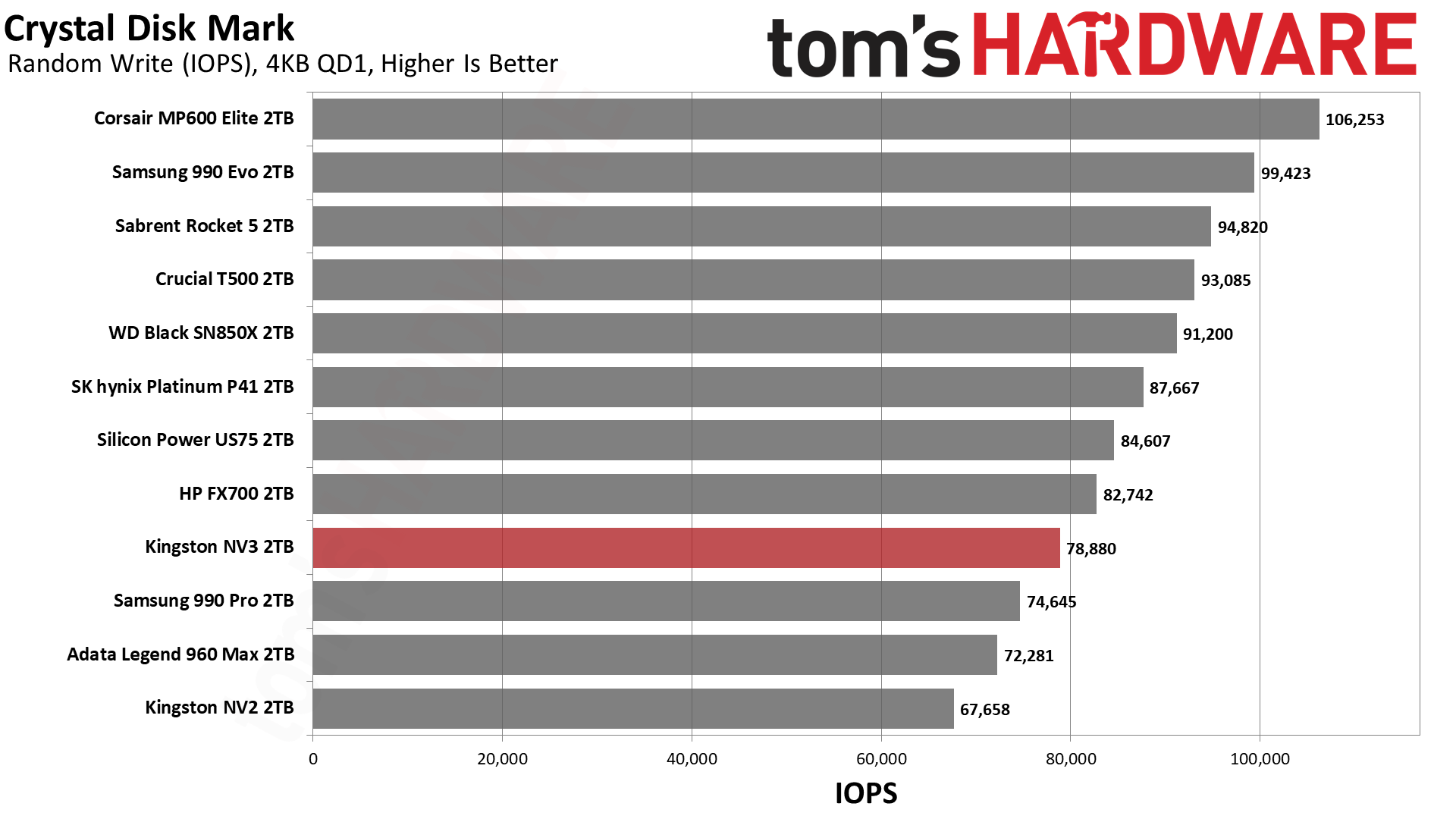


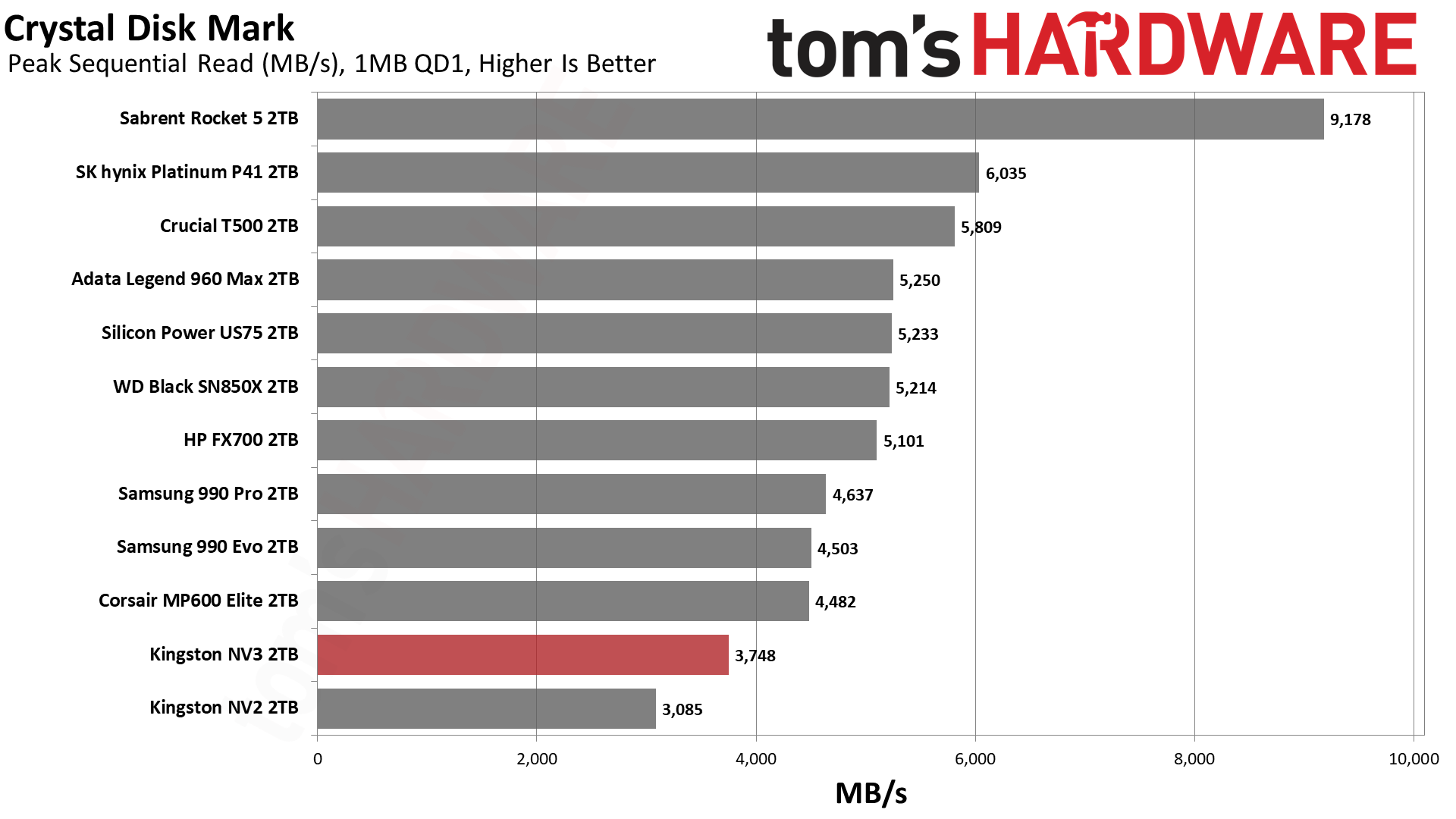



In ATTO, the NV3 doesn’t quite reach what's possible with the PCI 4.0 interface for writes at larger block sizes, and for reads it shows some uneven results. We’re not entirely sure what’s going on here, but we didn’t see it with the WD Blue SN5000, a drive that uses the same flash. It’s possible that this is an SM2268XT2 controller issue, which is relevant because you might get the MP600 Elite’s E27T instead on this drive. In any case, the read results at smaller block sizes — which people often carefully focus on — are relatively normal.
We see similar results in CDM. The NV3 can’t quite push the bandwidth as much as other drives. It does, however, dominate the older NV2. When looking at random performance, the NV3 is good enough but not great. Random read and write latency are both below expectations, particularly the former. We mentioned above that a shift in I/O rate can impact latency — the Crucial T705 compared to the Crucial T700 demonstrates this — but even with that consideration, these results are disappointing. That said, performance is still adequately superior to the last generation and this drive presents a viable upgrade path for anyone using an older SATA SSD.
Sustained Write Performance and Cache Recovery
Official write specifications are only part of the performance picture. Most SSDs implement a write cache, which is a fast area of pseudo-SLC (single-bit) programmed flash that absorbs incoming data. Sustained write speeds can suffer tremendously once the workload spills outside of the cache and into the "native" TLC (three-bit) or QLC (four-bit) flash. Performance can suffer even more if the drive is forced to fold, which is the process of migrating data out of the cache in order to free up space for further incoming data.
We use Iometer to hammer the SSD with sequential writes for over 15 minutes to measure both the size of the write cache and performance after the cache is saturated. We also monitor cache recovery via multiple idle rounds. This process shows the performance of the drive in various states as well as the steady state write performance.



The 2TB NV3 writes at almost 5.7 GB/s for just over 96 seconds in the faster pSLC mode. That indicates a 548GB cache. This mode is running the 4-bit QLC flash as 1-bit, so the cache is taking up four times the space for this speed advantage. Since this is a 2TB drive, that means more or less all of the flash is operating in the pSLC mode. This is very much expected for a drive of this type as the cache hides the native flash’s poor performance and it is usually large enough to do so. However, the cache will shrink in relative terms as the drive is filled.
Usually a large cache has rapid idle recovery, again to avoid being caught flat footed by I/O, but this can potentially induce more wear. As such, there’s a balance to be had. With the NV3, it’s more likely the cache will generally be sufficient as no one should buy this drive for heavy write workloads.
Still, if you do happen to exhaust the cache you will hit a folding QLC state that averages around 250 MB/s or so. This state occurs when the drive is forced to move data from the pSLC cache to the native QLC flash in order to free up space to accommodate future incoming data. Performance here is almost as bad as with the NV2, which is to be expected given the relatively small difference in the flash generations. If the NV3 has a real weakness, this is it, and the drive is more likely to reveal this issue when it's mostly filled with data. This isn’t an issue if you’re using it mostly for reads as a gaming or storage drive, but you might want to keep some space free if it ends up being your primary drive.
Power Consumption and Temperature
We use the Quarch HD Programmable Power Module to gain a deeper understanding of power characteristics. Idle power consumption is an important aspect to consider, especially if you're looking for a laptop upgrade as even the best ultrabooks can have mediocre stock storage. Desktops may be more performance-oriented with less support for power-saving features, so we show the worst-case.
Some SSDs can consume watts of power at idle while better-suited ones sip just milliwatts. Average workload power consumption and max consumption are two other aspects of power consumption but performance-per-watt, or efficiency, is more important. A drive might consume more power during any given workload, but accomplishing a task faster allows the drive to drop into an idle state more quickly, ultimately saving energy.
For temperature recording we currently poll the drive’s primary composite sensor during testing with a ~22°C ambient. Our testing is rigorous enough to heat the drive to a realistic ceiling temperature.

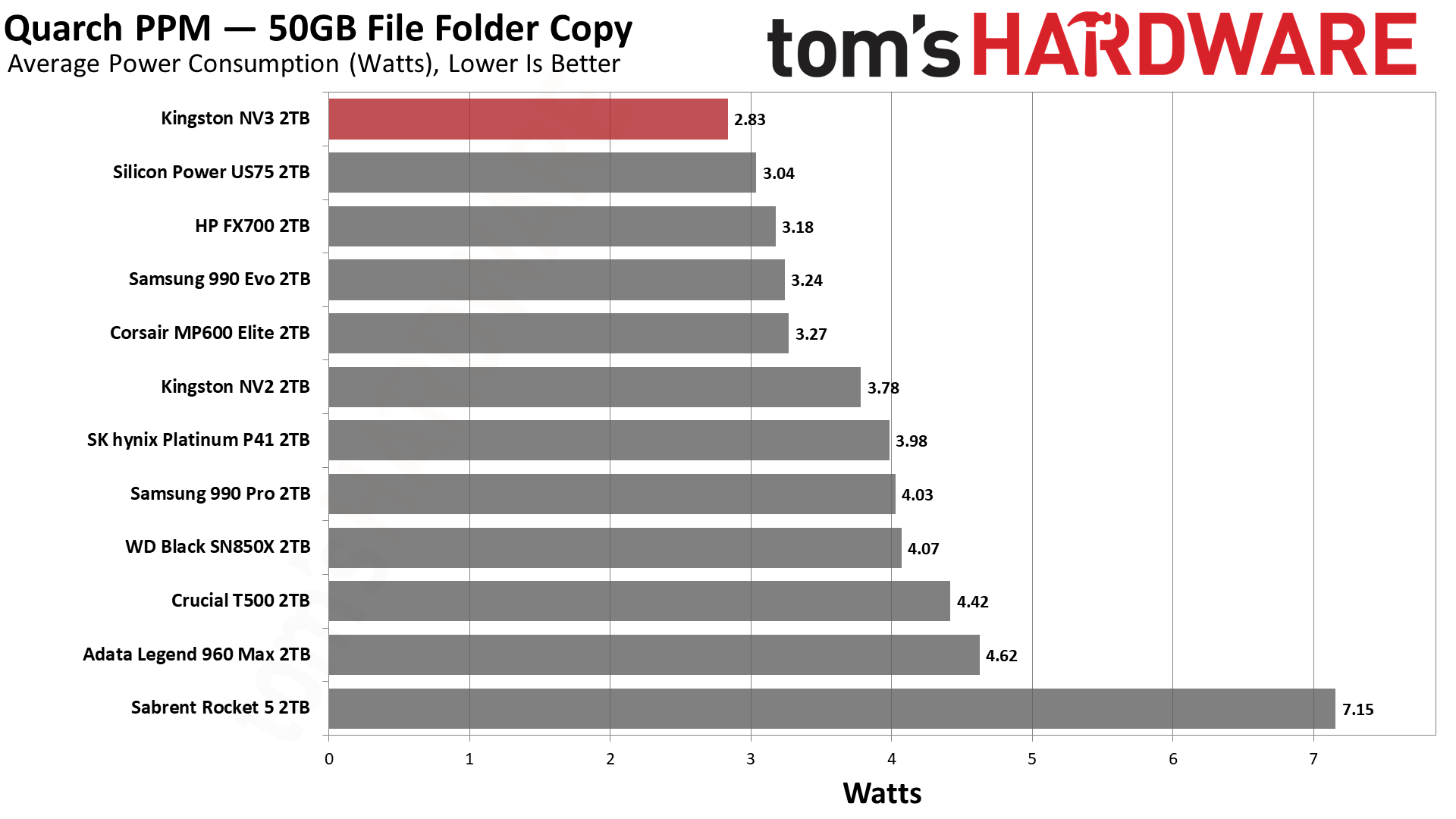


The NV2 ends up being very efficient, and in fact more efficient than the MP600 Elite. We know what to expect from this flash, so it’s possible SMI’s controller is doing good work here. No complaints.
One of the reasons we gave above for why Kingston might cap this drive is that it could help reliability, and one way that happens is by reducing the maximum load temperature. In our testing the NV3 — which has multiple sensors, but we used the higher one as it better reflects the controller temperature — only reached 48°C. This is very cool and well below the 75°C initial throttling state. If that threshold sounds low to you, it’s because it is. Most drives won’t throttle until the 80s or higher.
This reinforces our belief that Kingston is trying to have this drive run below peak theoretical performance to reduce the likelihood of overheating, among other things. Considering that the peak is still reasonably high and that sequential performance is only one part of the equation, this is a pretty good trade-off. This drive is bound to be popular worldwide and it’ll end up in a range of machines, including laptops and embedded devices, so setting the standard in this way ensures fewer edge case issues in a range of environments.
Test Bench and Testing Notes
| CPU | Intel Core i9-12900K |
| Motherboard | Asus ROG Maximus Z790 Hero |
| Memory | 2x16GB G.Skill DDR5-5600 CL28 |
| Graphics | Intel Iris Xe UHD Graphics 770 |
| CPU Cooling | Enermax Aquafusion 240 |
| Case | Cooler Master TD500 Mesh V2 |
| Power Supply | Cooler Master V850 i Gold |
| OS Storage | Sabrent Rocket 4 Plus 2TB |
| Operating System | Windows 11 Pro |
We use an Alder Lake platform with most background applications such as indexing, Windows updates, and anti-virus disabled in the OS to reduce run-to-run variability. Each SSD is prefilled to 50% capacity and tested as a secondary device. Unless noted, we use active cooling for all SSDs.
Kingston NV3 Bottom Line
Some might take one look at our score and come to the conclusion that the Kingston NV3 is a bad drive. "Only 60%? Pass." That would be incorrect, as this drive does many things right and certainly fills a hole in Kingston's SSD lineup. An example of a bad drive would be the AGI AI818 or, to a lesser extent, Kingston’s older NV2. Those two drives run hot and the NV3 doesn’t. They're inefficient and the NV3 is not. And they both have variable hardware with poor performance, while the NV3 — which does have variable hardware — performs adequately for a budget SSD even with the basic QLC flash configuration. This drive is likely to be equal or better than our review sample with another controller, like the Phison E27T, and/or with BiCS6 TLC flash.
On the other hand, there’s no denying the drive’s downsides. Its performance is capped below its full potential and sustained performance is weak compared to the competition, making the WD Blue SN5000 seem solid by comparison. As the hardware will vary from drive to drive and over time, you can never be quite sure of what you’ll get. This will inevitably make some users uncomfortable because they want to win the lottery with a TLC flash drive, or they just don’t want to play the lottery in the first place. To some extent, we're not as concerned here as with other drives, as the drive specifications are sufficient to ensure a relatively decent baseline. This was not the case with the NV2, which rolled off the line with questionable hardware from the get go.
The NV3 is meant to be a budget SSD and so we need to see it at the lower end of the price spectrum, where we find its competition. We gave two examples earlier with the Patriot Viper VP4300 Lite and Teamgroup MP44. We’ve noted that the former has swapped to QLC flash at 4TB and many budget champions, like the older Silicon Power UD90, have popped up with QLC flash at 2TB. The WD Blue SN580, WD Black SN770, and Teamgroup MP44L all remain great budget options, even if they don’t quite reach the performance level of the NV3. Additionally, the NV3 — along with the drives just listed — will beat pretty much any PCIe 3.0 drive out there, which brings us to price and availability.
The Kingston NV3, as priced at the time of review, is too expensive for the American SSD market. There are plenty of great drives, such as those listed above, at or below its price for all available capacities. There's no 4TB availability yet, but we assume that will be forthcoming, in which case the NV3 will likely be using QLC flash that pits it against additional drives like the Teamgroup MP44Q, Lexar NM790 or NQ790, Addlink A93, and more. This is a hill to climb and the NV3’s pricing has to be adjusted downward, especially as some recent trends have SSD prices going back down.
Kingston probably isn’t too worried about this as the NV3 will fly off the shelves for OEMs and builders, as well as in other regions where drives commonly have mystery hardware. The NV3’s specifications seem aimed at having a more reliable budget drive, despite the shorter warranty.
On the whole we think the Kingston NV3 has a place and that the company has done a good job of improving on the NV2. There are many generic brands out there, in the U.S. and other markets, that can be squeezed out by the superior Kingston presence. Kingston’s name is also good enough for prebuilts, including laptops, such that it will be able to make plenty of money off this drive.
It’s true that using variable hardware gives Kingston more flexibility, which can reduce the average price, but the reality is it will often be selling at higher prices than mixed drives from generic brands because it can. For the more discerning buyer, we can recommend the NV3 if you’re on a tight budget and want something reasonably fast with minimal hassle. Buy it, install it, and get on with your life — after all, not every SSD has to be flashy.
MORE: Best SSDs
MORE: How We Test HDDs And SSDs
MORE: All SSD Content
- 1
- 2
Current page: Kingston NV3 2TB Performance Results
Prev Page Kingston NV3 Features and Specifications
Shane Downing is a Freelance Reviewer for Tom’s Hardware US, covering consumer storage hardware.
-
Notton I would love to see the 4TB version get a review when it comes out.Reply
In particular, if it retains its single side or not. That was one of the selling points of the NV2 4TB. -
cyrusfox Truly impressive showing from a 3rd party ssd maker, Economical and super efficient gen 4 drive with decent endurance that scales as expected with higher density. Hats off to Kingston, this is a great drive. They should really consider making a 2230 version.Reply -
DavidLejdar SM2267XT here (TLC). So, the slower one. But still works fine after nearly two years of use for OS, drivers, and browser. CrystalDisk says the NV2 is at 98%, 16TB written. And that's after I moved the drive with 100% to the spot next to the GPU without a heatsink. And there it says 58°C, idle. That's noticeably higher than it was at the spot next to the CPU with a heatsink. But still fine. Not that the drive would get pushed much i.e. by the OS, which was designed to run on HDDs as well. And I did split stuff up on several drives, so basically I have like a stack of storage read/write capacity, run through 12 PCIe lanes, and likely adding a Gen5 at some point.Reply
Even Gen3 is still a huge step-up from a Sata SSD though - not only because of the "max speed", but also due to having way more queues, which helps to remove a sort of "desktop lag" that can be easily seen on older rigs (incl. CPU) when there is stuff going on, like downloading and installing something (which takes up HW capacity), running the browser, which also wants to access something, such as RAM and that HDD/SSD, all on an internet connection which may in some cases exceed the speed of HDDs (like, what gets downloaded to the HDD, waits around the modem to be able to actually get processed onto the HDD).
So, what I am tryingto say is that a "budget M.2 SSD" is plenty for casual use of a PC. Even when one pushes for like 4K/8K gaming capability of a rig, or something, (such as being able to fill the entire VRAM within seconds, and a 12GB VRAM within a second with a Gen5 SSD), there is still some use for a simple drive, to chill alongside.
